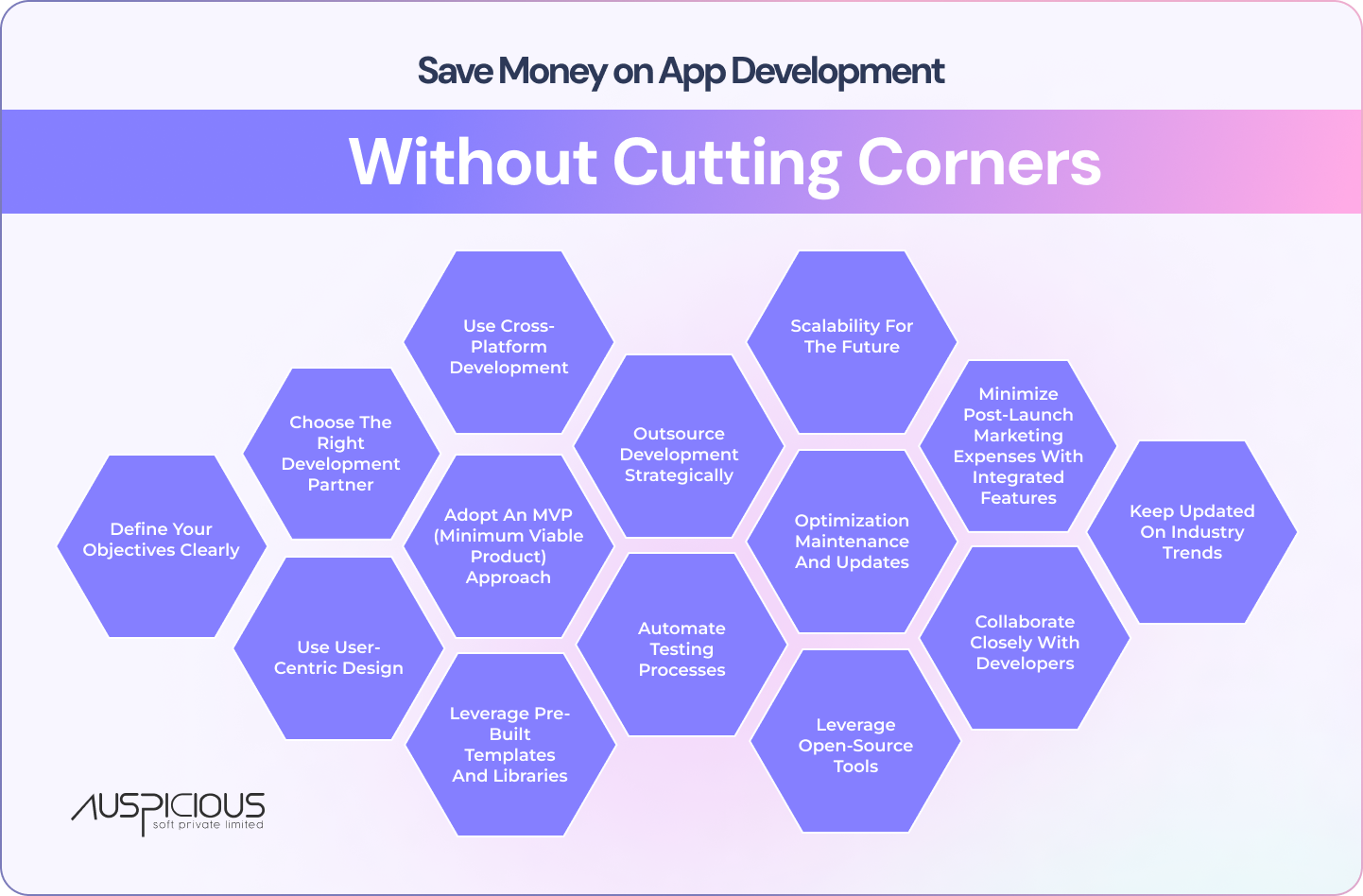How to Save Money on App Development Without Cutting Corners
In today’s world of digitization, mobile apps are no longer a luxury but a necessity for businesses across all industries. However, the process of developing an app can be costly, especially when striving for quality and functionality. For businesses with tight budgets, cutting costs while ensuring a high-quality product becomes a balancing act. The good news is that you can save money on app development without sacrificing quality by adopting smart strategies and leveraging custom software development and professional mobile app development services.

Here’s a comprehensive guide to help you save money on app development without compromising on features, design, or performance.
1. Define Your Objectives Clearly
Before embarking on app development, it is important to have clear goals, target audience, and functionality in mind. A clear roadmap can help avoid costly revisions later in the development process. Work closely with a custom software development team to outline the primary objectives of your app and must-have features.
By focusing on essential functionalities and deferring non-critical features for future updates, you can reduce initial development costs. Mobile app development services providers often recommend this phased approach to ensure cost efficiency.
2. Choose the Right Development Partner
Save money on quality by the right partner. Experienced mobile app development services providers bring efficiency and expertise to the table to avoid common pitfalls. You may want to research potential partners by checking portfolios, client testimonials, and reviews.
Look for developers who are well versed in custom software development and can tailor solutions according to your needs. Going for a reliable partner may look expensive at first, but it reduces the risk of low-quality results and costly fixes later.
3. Use Cross-Platform Development
The development of separate apps for iOS and Android can double the expenses. Cross-platform development frameworks like Flutter or React Native can be used, allowing developers to create a single codebase that works across multiple platforms, cutting costs considerably.
Many mobile app development services providers specialize in cross-platform development, so your application will reach a wider audience without inflating your budget. Cross-platform tools also speed up the development process, saving time and money.
4. Adopt an MVP (Minimum Viable Product) Approach
An MVP is a version of your app with the most basic features required to fulfill the needs of users. Launching an MVP enables you to test the market, gather user feedback, and refine your app according to real-world usage.
Custom development of an MVP for reducing costs at the starting point of the project would help assure that future implementations would adhere to the demands of end-users. That way, you can only spend where it matters by prioritizing features that maximize value to users.
5. Use user-centric design.
A user-friendly interface is a prerequisite for any app. But excessive spending on lavish designs may cause unnecessary increase in cost. Collaborate with mobile app development services providers who give emphasis to simple and functional designs. A clean and intuitive interface saves the development time and also makes it appealing to users.
Custom design elements should be used only for features that really add to usability or make your app stand out from others. By being picky, you can have a professional look without breaking the bank.
6. Leverage Pre-Built Templates and Libraries
It takes time and money to develop each part of your app from scratch. Use pre-built templates, libraries, and frameworks instead to save time and money. Most custom software development providers use these resources to speed up development without compromising on quality.
For example, authentication modules, payment gateways, and UI elements are usually ready-made solutions. Using such components decreases the development hours and costs associated with it.
7. Automate Testing Processes
Testing is a very important part of app development, but manual testing is very time-consuming and expensive. Automation tools help to streamline testing by identifying bugs and performance issues more efficiently. Partner with mobile app development services providers who use automated testing to ensure your app meets quality standards without stretching the budget.
Automated testing also saves time for updates and maintenance, which is long-term savings.
8. Outsource Development Strategically
Outsourcing app development to regions with lower labor costs can significantly reduce expenses without compromising quality. Countries like India, Ukraine, and the Philippines offer access to skilled developers at competitive rates.
When outsourcing, look for teams experienced in custom software development and familiar with your industry’s requirements. Clear communication and robust project management tools are essential to ensure the project stays on track and meets your expectations.
9. Scalability for the Future
Short-term cost savings should not compromise long-term scalability. An app that has a flexible and scalable architecture can adapt to increasing user demands and easily add new features. Discuss scalability requirements with your mobile app development services provider in the planning phase.
Investing in scalable solutions from the initial stages minimizes the likelihood of costly overhauls. This foresight keeps your app cost-effective across the lifecycle.
10. Optimization Maintenance and Updates
For an app, maintenance is a recurring cost. To limit that cost, work with custom software developers who create efficient code which is well-documented, and clean codebase for an app makes easier as well as cheaper to maintain.
In addition, update prioritization should be based on user feedback and market trends. Minor updates should be released regularly rather than trying to change the app all at once. This spreads costs over time and ensures continuous improvement.
11. Leverage Open-Source Tools
Open-source tools and platforms help reduce the cost of proprietary software. Starting from the development framework to analytics, open-source solutions provide all functionalities at minimal or zero cost. Most mobile app development services providers use such tools to minimize costs while maintaining quality.
However, make sure that the tool you are using fits your requirements and the security level of your app.
12. Minimize Post-Launch Marketing Expenses with Integrated Features
The inclusion of marketing features in your app saves money on external advertising. For example, you can boost user engagement and organic growth by using push notifications, referral programs, or in-app promotions.
Discuss these features with your custom software development partner during the design phase. You can reduce the need for costly third-party advertising campaigns by building marketing capabilities right into your app.
13. Collaborate Closely with Developers
Miscommunication and unclear requirements can result in costly revisions and delays. Maintain regular communication with your development team to ensure alignment at every stage. Be it in-house developers or outsourcing to mobile app development services, collaboration is the way to avoid unnecessary expenses.
Tools such as Trello, Asana, and Slack facilitate transparent project management and real-time updates that keep the development process on track.
14. Keep Updated on Industry Trends
The tech landscape is highly dynamic, with new tools and methodologies constantly surfacing. By keeping up with trends, you get to notice a cost-saving opportunity. For example, AI and machine learning development have led to smarter automation. This reduces manual effort and expenditure.
By collaborating with the providers of mobile app development services who are ahead of the trend curve, you ensure your application remains innovative and economical.
Conclusion
Mobile application development doesn’t need to break the bank. In fact, with these strategies in place, you can develop mobile apps that are not so pricey and yet high-quality standards are met. Be it in custom software development, strategically outsourcing, or keeping in mind scalability, it strikes a balance between performance and cost.
Partnering with proficient mobile app development services suppliers is crucial to achieving that. Their expertise in optimizing a process and using cost-effective tools ensures that your app won’t only fit your budget but also exceed user expectation. Planning wisely and focusing more on long-term value will certainly help you develop an app worthy of standing out in the market rather than cutting corners.
TABLE OF CONTENT
- How to Save Money on App Development Without Cutting Corners
- 1. Define Your Objectives Clearly
- 2. Choose the Right Development Partner
- 3. Use Cross-Platform Development
- 4. Adopt an MVP (Minimum Viable Product) Approach
- 5. Use user-centric design
- 6. Leverage Pre-Built Templates and Libraries
- 7. Automate Testing Processes
- 8. Outsource Development Strategically
- 9. Scalability for the Future
- 10. Optimization Maintenance and Updates
- 11. Leverage Open-Source Tools
- 12. Minimize Post-Launch Marketing Expenses with Integrated Features
- 13. Collaborate Closely with Developers
- 14. Keep Updated on Industry Trends
- Conclusion
